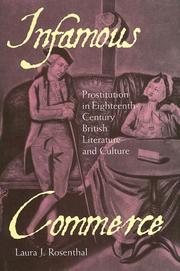| Listing 1 - 3 of 3 |
Sort by
|
Book
ISBN: 2600003657 9782600003650 Year: 1999 Volume: 77 Publisher: Genève Droz
Abstract | Keywords | Export | Availability | Bookmark
 Loading...
Loading...Choose an application
- Reference Manager
- EndNote
- RefWorks (Direct export to RefWorks)
Prostitutie in de literatuur --- Prostitution dans la littérature --- Prostitution in literature --- Delicado, Francisco, --- Aretino, Pietro, --- Prostitution in literature. --- Spanish literature --- Italian literature --- History and criticism. --- Delicado, Francisco --- Aretino, Pietro --- Spanish literature - Classical period, 1500-1700 - History and criticism. --- Italian literature - 16th century - History and criticism.
Book
ISBN: 2600000232 9782600000239 Year: 1995 Volume: 69 Publisher: Genève Droz
Abstract | Keywords | Export | Availability | Bookmark
 Loading...
Loading...Choose an application
- Reference Manager
- EndNote
- RefWorks (Direct export to RefWorks)
Prostitutie in de literatuur --- Prostitution dans la littérature --- Prostitution in literature --- Comedy --- Criminals in literature --- Spanish literature --- Comédie --- Criminels dans la littérature --- Littérature espagnole --- History and criticism --- Histoire et critique --- Pimps in literature. --- Procuresses in literature. --- History and criticism. --- Prostitutes in literature. --- Comédie --- Criminels dans la littérature --- Prostitution dans la littérature --- Littérature espagnole --- Spanish drama --- Classical period, 1500-1700 --- Spanish drama (Comedy) --- Spanish literature - Classical period, 1500-1700 - History and criticism.

ISBN: 0801444047 9780801444043 1336208104 0801454352 9780801454356 Year: 2006 Publisher: Ithaca Cornell University Press
Abstract | Keywords | Export | Availability | Bookmark
 Loading...
Loading...Choose an application
- Reference Manager
- EndNote
- RefWorks (Direct export to RefWorks)
In Infamous Commerce, Laura J. Rosenthal uses literary and historical sources to explore the meaning of prostitution from the Restoration through the eighteenth century, showing how both reformers and libertines constructed the modern meaning of sex work during this period. From Grub Street's lurid "whore biographies" to the period's most acclaimed novels, the prostitute was depicted as facing a choice between abject poverty and some form of sex work.Prostitution, in Rosenthal's view, confronted the core controversies of eighteenth-century capitalism: luxury, desire, global trade, commodification, social mobility, gender identity, imperialism, self-ownership, alienation, and even the nature of work itself. In the context of extensive research into printed accounts of both male and female prostitution-among them sermons, popular prostitute biographies, satire, pornography, brothel guides, reformist writing, and travel narratives-Rosenthal offers in-depth readings of Samuel Richardson's Clarissa and Pamela and the responses to the latter novel (including Eliza Haywood's Anti-Pamela), Bernard Mandeville's defenses of prostitution, Daniel Defoe's Roxana, Henry Fielding's Tom Jones, and travel journals about the voyages of Captain Cook to the South Seas. Throughout, Rosenthal considers representations of the prostitute's own sexuality (desire, revulsion, etc.) to be key parts of the changing meaning of "the oldest profession."
Prostitutie in de literatuur --- Prostitution dans la littérature --- Prostitution in literature --- Fiction --- Sociology of the family. Sociology of sexuality --- anno 1700-1799 --- Great Britain --- Prostitution in literature. --- Prostitution --- English literature --- Female prostitution --- Hustling (Prostitution) --- Prostitution, Female --- Sex trade (Prostitution) --- Sex work (Prostitution) --- Street prostitution --- Trade, Sex (Prostitution) --- White slave traffic --- White slavery --- Work, Sex (Prostitution) --- Sex-oriented businesses --- Brothels --- Pimps --- Procuresses --- Red-light districts --- Sex crimes --- History --- History and criticism. --- Prostitutes in literature. --- 18th century --- History and criticism --- Sex work --- Literature --- Book --- Imaging
| Listing 1 - 3 of 3 |
Sort by
|

 Search
Search Feedback
Feedback About UniCat
About UniCat  Help
Help News
News